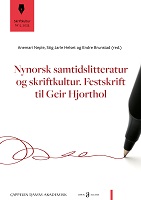Nynorsk samtidslitteratur og skriftkultur. Festskrift til Geir Hjorthol
Author(s)
Brekke, Marit
Herlofsen, Brage Egil
Hjorthol, Geir
Hårstad, Stian
Reed, Beatrice G.
Rogne, Wenke Mork
Simonhjell, Nora
Stengrundet, Elin
Sørbø, Marie Nedregotten
Sørbø, Jan Inge
Contributor(s)
Neple, Anemari (editor)
Jarle Helset, Stig (editor)
Brunstad, Endre (editor)
Language
Norwegian NynorskAbstract
This issue of Skriftkultur stems from our desire to honor our good colleague Geir Hjorthol with a festschrift on the occasion of his 70th birthday. As the recipient is a professor of literature and also interested in literary culture studies more generally, we have titled the issue Norwegian Nynorsk contemporary literature and written culture.
Geir Hjorthol is himself responsible for the first article, in which he focuses on the role of music within Jon Fosses' novel, Septologien (2019–2022). This article became no less relevant when, a few weeks prior to completion of the issue, Fosse received the Nobel Prize in Literature 2023, the first Norwegian Nynorsk author in the prize’s history.
In the second article, Jan Inge Sørbø questions whether reading literature may be stuck in a critical rut, where one is constantly occupied with revealing something hidden in the text.
The four subsequent articles explore various recent Norwegian Nynorsk novels or authorships. In the first of these, Elin Stengrundet reflects on how Erlend Skjetne's young adult novel Eit anna blikk (2021) connects to modern migration literature and the Norwegian Nynorsk literary tradition, while Nora Simonhjell's article sheds new light on the inner coherence in the authorship of Olaug Nilssen. Marit Brekke and Wenke Mork Rogne present a post-humanistic reading of the Is-slottet (1963) by Tarjei Vesaas, while Beatrice G. Reed examines the precence of nature in Norwegian Nynorsk picture books for children in our time by taking a closer look at 13 prize-winning Norwegian Nynorsk picture books published up until the year 2000.
Non-fiction and the topic of translation are covered by the next two articles. Brage Egil Herlofsen discusses the relationship between Norwegian Nynorsk literary culture and the essay genre, based on two books from the Norsk røyndom-series published by Samlaget (2018), while Marie Nedregotten Sørbø analyzes translations of Jane Austen from English to Norwegian nynorsk in light of literary cultural and hermeneutical perspectives.
In the last article, Stian Hårstad shows how the language culture of our time places emphasis on increased pluralization, not least through the rise of digital technology, which facilitates new forms of interaction via writing, before discussing possible consequences this may have for written culture in general, and for studies of written cultures. Bakgrunnen for dette nummeret av Skriftkultur var at vi ville heidre vår gode kollega og fagfelle Geir Hjorthol med eit festskrift i høve hans 70-årsdag. Sidan festskriftmottakaren er litteraturprofessor og dessutan er interessert i skriftkulturstudiar meir generelt, valde vi å gje festskriftet tittelen Nynorsk samtidslitteratur og skriftkultur.
Geir Hjorthol står sjølv for den første artikkelen om Jon Fosses Septologien (2019–2022), og her rettar han søkjelyset mot forholdet til musikk i romanen. Denne artikkelen blei ikkje mindre aktuell då det nokre veker før festskriftet var ferdig, blei klart at Fosse fekk Nobelprisen i litteratur 2023, som den første nynorskforfattaren nokosinne. I den andre artikkelen stiller Jan Inge Sørbø spørsmål om lesing av litteratur kan ha køyrt seg fast i eit kritisk spor der ein heile tida er oppteken av å avsløre noko som er skjult i teksten.
Deretter følgjer fire artiklar som tek føre seg ulike nyare nynorske romanar eller forfattarskapar. I den første av desse reflekterer Elin Stengrundet over korleis Erlend Skjetnes ungdomsroman Eit anna blikk (2021) knyter an til moderne migrasjonslitteratur og den nynorske litteraturtradisjonen, medan Nora Simonhjell sin artikkel kastar nytt lys over den indre samanhengen i forfattarskapen til Olaug Nilssen. Marit Brekke og Wenke Mork Rogne presenterer ei posthumanistisk lesing av Is-slottet (1963) av Tarjei Vesaas, medan Beatrice G. Reed undersøker graden av naturorientering i nynorske biletbøker for barn i vår tid ved å sjå nærare på 13 prislønte nynorske biletbøker utgjevne etter år 2000.
Sakprosasjangeren og temaet nynorsk omsetjing blir dekt av dei to neste artiklane i festskriftet. Brage Egil Herlofsen drøftar forholdet mellom nynorsk skriftkultur og essaysjangeren med utgangspunkt i to bøker frå Norsk røyndom-serien til Samlaget (2018), medan Marie Nedregotten Sørbø analyserer omsetjingar av Jane Austen frå engelsk til norsk i lys av skriftkulturelle og hermeneutiske perspektiv.
I den siste artikkelen viser Stian Hårstad korleis vår tids språkkultur legg vekt på auka pluralisering og folkeleggjering, ikkje minst gjennom framveksten av digital teknologi som legg til rette for nye former for skriftbasert samhandling, før han drøftar kva for konsekvensar dette kan ha for skriftlegheita og for skriftkulturforskinga.
Keywords
Norwegian Nynorsk, literature, written culture, picture books, essay theory, translation, sociolingustics of writing, nynorsk, litteratur, skriftkultur, Fosse, Skjetne, Nilssen, Vesaas, biletbøker, essayistikk, omsetjing, skriftsosiolingvistikkDOI
10.23865/noasp.204ISBN
9788202826710, 9788202830991, 9788202831004, 9788202831011, 9788202826703Publisher website
https://www.cappelendamm.no/Publication date and place
Oslo, 2023Grantor
Series
Skriftkultur, 5Classification
Norwegian
Literature: history and criticism


 Download
Download Web Shop
Web Shop